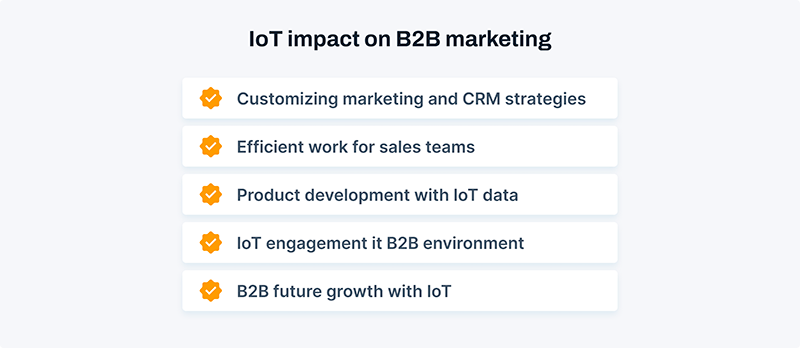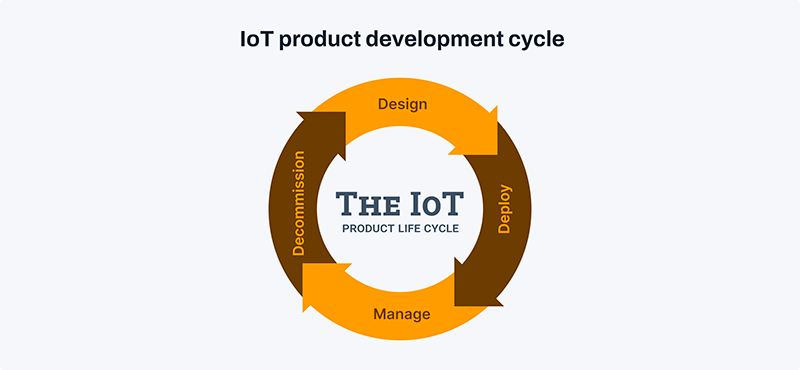How the IoT Boosts B2B Marketing and Customer Engagement
February 19, 2024The Internet of Things is a crucial aspect of today's technology-driven world. It connects various aspects of our lives to the internet. The effective use of IoT can have an unparalleled impact on B2B marketing.
In the B2B marketing industry, harnessing the power of the IoT has become increasingly vital. IoT offers innovative solutions that revolutionize how businesses connect, interact, and engage with their target audience. This article explores the transformative potential of IoT in B2B marketing, highlighting its key features, benefits, and applications for businesses striving to stay ahead in today's competitive landscape.
The impact of IoT on B2B marketing

The IoT has made a significant impact across industries, including B2B marketing. Surprisingly, around 51% of marketing experts believe that the IoT has the potential to reshape the marketing landscape. By leveraging IoT, B2B marketers can personalize their targeting, build stronger client relationships, innovate products, track the buyer's journey, and stay ahead of industry trends.
Customized marketing and CRM strategies
Engaging with customers and nurturing connections are essential for marketing and managing customer relationships. Usually, the first interaction between a customer and a business involves encountering a marketing asset. Ongoing communication and engagement are handled through customer relationship management (CRM).
Businesses can use IoT technology to leverage data to create more effective customer engagement strategies. This valuable information guides targeting and messaging in marketing campaigns.
Furthermore, usage data plays a crucial role in monitoring engagement levels. A decline in usage or underutilization of product features may indicate issues. Proactive communication becomes essential.
This type of communication adds a personal touch by utilizing data to understand that a new customer has to explore the product's features. This approach aims to increase customer engagement and retention rates, ultimately improving the customer's lifetime value.
There are many examples of this IoT engagement approach. Additionally, businesses can segment their marketing target audiences based on various factors, such as location and behavior.
Thanks to accurate and real-time data provided by IoT technology, businesses can now build stronger connections with their customers than ever before.
Efficient work for sales teams
In B2B environments, marketing strategies may attract potential customers, but usually sales teams retain them. Sales teams play a crucial role in the customer journey, and leveraging customer data is essential for success. Fortunately, the IoT handles this seamlessly.
To elaborate, marketing teams use IoT data to understand and categorize target audiences, and sales teams can use customer data to guide their conversations with potential clients. For instance, if IoT sensors reveal that property managers in warmer areas often require additional maintenance for basic air conditioning units, the sales team can suggest offering more durable units that require less upkeep or bundling a maintenance service.
The IoT provides updates on usage, maintenance needs, ink levels, and other critical information. It allows businesses to address issues promptly, leading to higher customer satisfaction.
Product development connections with IoT data
Development teams interact directly with customers. Constant improvement of products can lead to better loyalty. Customer feedback, reviews, and insights from CRM teams can provide valuable information about trends and pain points.
IoT sensors collect raw data on real-time usage and location, which can enhance the accuracy of client feedback. This data can also guide the development of aftermarket products and services that align with the identified trends. For example, if customers prefer self-replacing air conditioning filters, replacements can be engineered for easier use.
This data can also help with sales. If unit sensors detect a need for filter changes or maintenance, sales teams can proactively engage with individuals. When sensors signal maintenance needs or efficiency opportunities, businesses can refine their products and enhance the customer journey. Exceptional experiences lead to people's engagement and ultimately foster long-lasting customer relationships.
B2B engagement with the IoT
Businesses use the IoT to improve their transportation, maintenance, and inventory processes by boosting customer engagement and operational efficiency.
For instance, in transportation and telematics, the IoT enables accurate vehicle tracking, route optimization, and efficient service delivery for fleet management. That allows service vehicles to adjust their real-time routes based on traffic updates and easily log completed tasks during service calls. Additionally, customers can track the location of approaching service vehicles and receive accurate invoices generated by IoT sensors.
Some IoT inventory innovators use smart shelves that automatically communicate ordering requirements to manufacturers. This data is also shared with shipping partners, providing estimates on shipment size, delivery dates, and destinations. Ultimately, these advancements ensure that products are readily available when customers need them.
B2B future growth with IoT
There are many ways to take advantage of IoT technology, such as targeting specific groups of customers, keeping warehouses stocked, and using innovative IoT billing methods. The IoT drives innovation in businesses, as seen through the accomplishments of key players in big data like Facebook, Amazon, Alphabet (Google), Apple, and Microsoft.
Although the IoT doesn’t provide all the solutions for businesses looking to improve customer engagement, it offers valuable data to help discover them.
How do B2B marketers use IoT technology?
Strong relationships with customers
Establishing strong and long-lasting relationships with clients is essential to understanding their needs and challenges and proactively addressing them. The IoT can be a game-changer in this regard.
IoT applications collect vast amounts of data, providing valuable insights tailored to each client's requirements. By analyzing this data and putting yourself in your client's shoes, a business can better understand their perspective and cater to their needs. It is essential to know how a product can benefit customers and communicate with them effectively.
Trend awareness
The IoT market is projected to experience tremendous growth over the next decade. Projections indicate that by 2030, there will be a staggering 24.1 billion IoT devices worldwide, generating an impressive $1.5 trillion in annual revenue.
Given this forecast, B2B marketers must stay informed about the evolving landscape. For example, edge computing emerges as a noteworthy IoT trend to monitor closely this year.
In addition, it's essential to keep an eye on industry-specific IoT trends, such as IoT-enabled devices and cloud computing. Businesses can improve their marketing strategies and maintain a lead over rivals in the industry by using these trends in the right way.
Perfect timing
Timing plays a crucial role in marketing, particularly in the digital realm. Getting the timing right offers several advantages, with enhanced client engagement being the most significant.
IoT pinpoints the ideal moment to send a marketing email or share social media posts to become more manageable. B2B marketers can leverage the real-time data provided by IoT to analyze trends in client responses and tailor strategies accordingly.
After analyzing trends, businesses can determine the optimal timing and frequency that resonate best with their clients.
For example, if you're targeting two distinct demographics, such as demographic A, which is active on LinkedIn, and demographic B, which is active on Facebook, you can simultaneously promote your products on both platforms. This strategy directs client traffic to your website's product pages.
By reaching out to clients at the ideal time and on the appropriate platform, they're more likely to be receptive to messages, leading to higher conversion rates.
New product or service development

Marketing is not only about selling services but also about discovering opportunities for new product development. IoT has a key role in this process.
For instance, IoT applications are customized to gather and transmit data when customers use products. This data includes customer feedback, product performance insights, issues, and defects. You can learn a lot about what works and what doesn't by analyzing this data, which allows you to innovate and develop new products and services.
Provided personalization
Personalized services and marketing approaches have become increasingly important for clients in today's business world. According to Forbes, almost 94% of senior business executives share this view.
IoT devices are specifically designed to collect and analyze data. B2B marketers use this data to gain insights into how their clients respond. Based on these insights, customized marketing strategies can be developed, such as crafting personalized calls-to-action (CTAs) and content for marketing emails.
Furthermore, B2B marketers can use this data to segment their diverse customer base. This allows them to send targeted product or service pitches that align with the specific needs of each target demographic.
Conclusion
Integrating IoT technology into B2B marketing strategies can bring unprecedented opportunities for enhanced client engagement and tailored approaches. By utilizing the power of IoT data, marketers can personalize their outreach, optimize timing, and develop innovative products and services to meet the ever-changing needs of their clients.
As the IoT continues to evolve, B2B marketers must stay vigilant and leverage these advancements to stay ahead of the curve, driving sustainable growth in their businesses.
